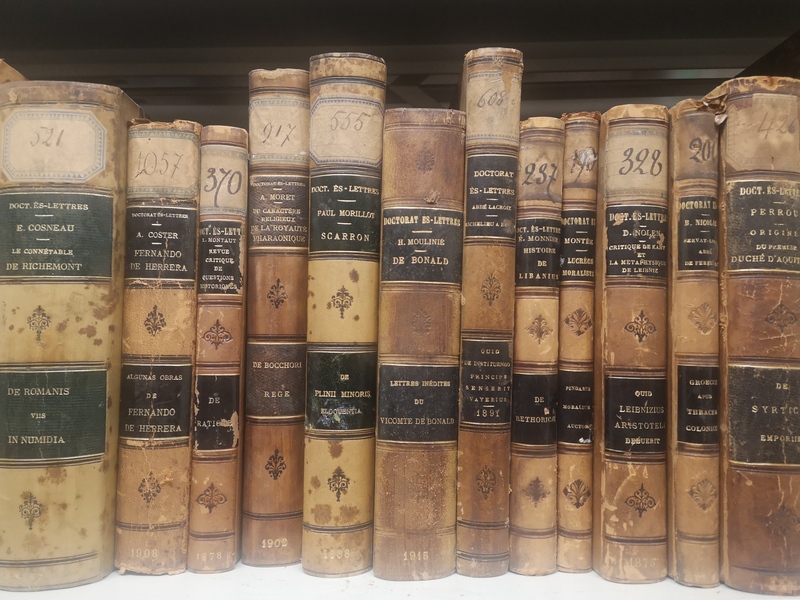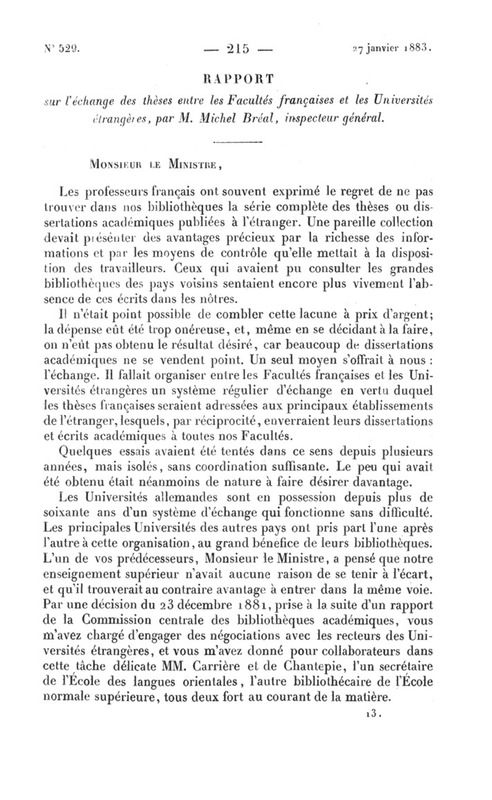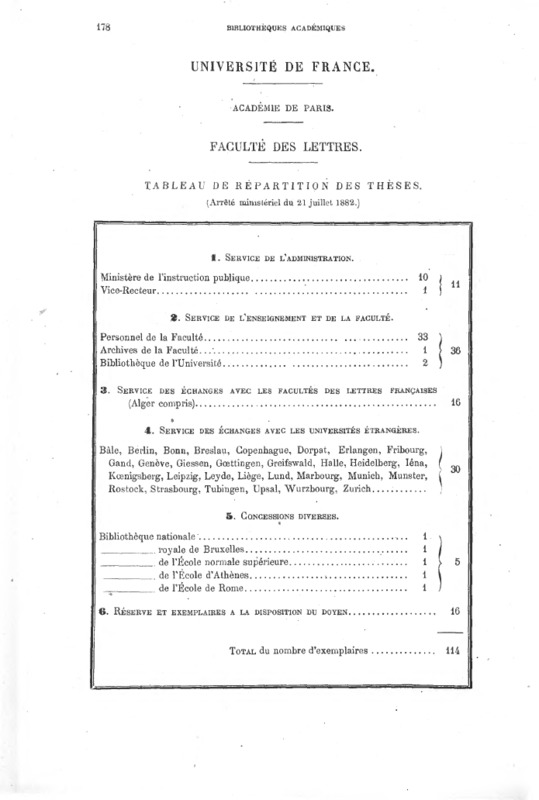The installation of theses on the shelves of university libraries
The Bibliothèque interuniversitaire de la Sorbonne (BIS) boasts an almost exhaustive collection of doctoral theses ès lettres from 1811 to at least 1939. Notably, the Faculty of Letters in Paris awarded four out of five degrees in the nineteenth century, and its library inherited the so-called “ministerial” collection. This collection was created following a circular from the Grand Master of the University dated June 8, 1811, which extended to other faculties the obligation imposed since 1809 on candidates for the doctorate in law to send two copies to the University Council – in addition to the copies that had to be sent to each of the faculty’s teachers. The implementation of this directive appears to have been gradual, as evidenced by a circular dated November 3, 1815, which expressed regret that “for some time the faculties have neglected to attach to the certificates of aptitude [...] the two copies of the theses defended”. This reminder was accompanied by a justification: if the central administration requested these copies, it wasin order to“gather all the information that can enable it to compare and know well the strength of studies in the higher schools”. The Royal Council of Public Instruction, which replaced the University Council in 1820, and then the Ministry of Public Instruction, created in 1824, inherited this prerogative. However, these institutions had neither the mission nor the means to preserve in perpetuity large collections of academic works: from an early stage, they opted to donate the volumes they received to the Sorbonne library. This is the reason why the thesis collection in this library was the most comprehensive, and indeed the only systematic one prior to 1841 [fig. 1].
By thedecree of December 7, 1841, the Royal Council of Public Instruction, “considering that there is an inequality between the doctoral theses admitted by the various Faculties of Letters in the kingdom, which an exchange of these theses, regularly established between the faculties, would help to eliminate”, added to the two copies required of each candidate since 1811 a number of copies “equal to that of the other Faculties of Letters in the kingdom”. In a circular accompanying the decree on January 12, 1842, Minister Abel-François Villemain, specified that the objective was twofold: to strengthen the collections of non-Parisian faculty libraries, and to encourage emulation among candidates: “Aspirantsto the doctorate will be all the more careful in their compositions, as their work is intended to receive greater publicity”. In practice, however, these mailings were conducted in an imperfect manner, giving rise to numerous complaints, particularly due to the significant financial burden placed on candidates.
In order to defend the intellectual status of the new Third Republic, circulars signed by Minister Jules Ferry proposed to extend this system of reciprocal sending of theses abroad. The circulars of September 10, 1877, and March 26, 1879, stipulated that the library of Ghent, in Belgium, and the library of the University of Alsace-Lorraine, headquartered in Strasbourg, should receive a copy of every doctoral thesis, on condition that they send in return the theses defended in Belgium and Germany, respectively. France thus became part of a system of exchange (Tausch-Verein) that had emerged in the Germanic area in 1817, on the initiative of the University of Marburg, and that by the 1870s encompassed some fifty German, Dutch, Swedish, and Swiss universities. It is notable that no comparable system existed in the United Kingdom or the United States. This policy was systematized by the decree concerning the thesis exchange service of April 30, 1882. The sole article of this decree stipulated that “in each faculty thirty copies shall be taken from the number of theses required of candidates, intended for the service of the exchange of theses and academic publications with foreign universities”. The accompanying circulars of May 17 and 31 explained that the aim was to join theTausch-Verein: French faculties should receive, on an annual basis, a collection of theses from foreign universities in exchange. The objectivewas twofold: to further strengthen the collections of university libraries; to disseminate French scholarship, as“it happens too often that the most remarkable of our university theses are completely forgotten because they hardly leave the environment in which they were defended”. In January 1883, Michel Bréal, then Inspector General, was able to draw a flattering portrait of the system in place that had been established, emphasizing the extent to which“academic dissertations are one of the surest bases for assessing the strength of a country’s scholarship” [fig. 2].
The thesis exchange service had to be radically reorganized, which was done by the decree of July 21, 1882. The number of copies required was now fixed annually by ministerial decree, and the responsibility of exchanges was transferred from the faculty and the rectorate to the librarians. The requested copies had six clearly defined destinations: the administration; the faculty itself; exchanges with French faculties; exchanges with foreign universities; “miscellaneous concessions”, i.e. agreements with non-university libraries, such as the Bibliothèque nationale; reserve copies and copies at the dean’s disposal. The number of copies required of candidates increased significantly: in 1882-1883, 114 copies were required in the Faculty of Letters in Paris, 94 in the other faculties [fig. 3 and 4].
The final element of the new system for publicizing doctoral theses was the establishment of an official annual catalogue. This was created by circular of June 25, 1885, which established the Catalogue des theses et écrits académiques provenant des facultés françaises, prepared by the Sorbonne library andpublished annually by the Imprimerie Nationale. This served as an official list [fig. 4]. This system, the first of its kind in the world, allowed the central administration to monitor the distribution of theses without having to intervene directly in the distribution and circulation of copies. To the great pride of the French ministry, German universities set up a similar system the following year. This international system effectively ceased to existwith the advent of the First World War, only to be superseded in 1923 by a new one, designed as a lever of diplomatic offensive,whereby the government itself determined which foreign universities would receive the copies. In 1923, the number of copies required from doctoral candidates was fixed at 95 in Paris and 80 in the départements, for 44 recipient universities. This was subsequently increased to 160 in 1951 (including 60 for university exchanges), before the obligation to print theses was abolished in 1969. Offset reproduction was hereafter provided free of charge by the Atelier national de reproduction des thèses, created at the University of Lille III.



